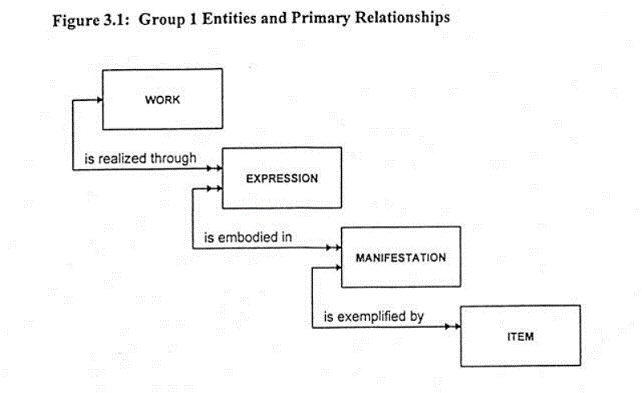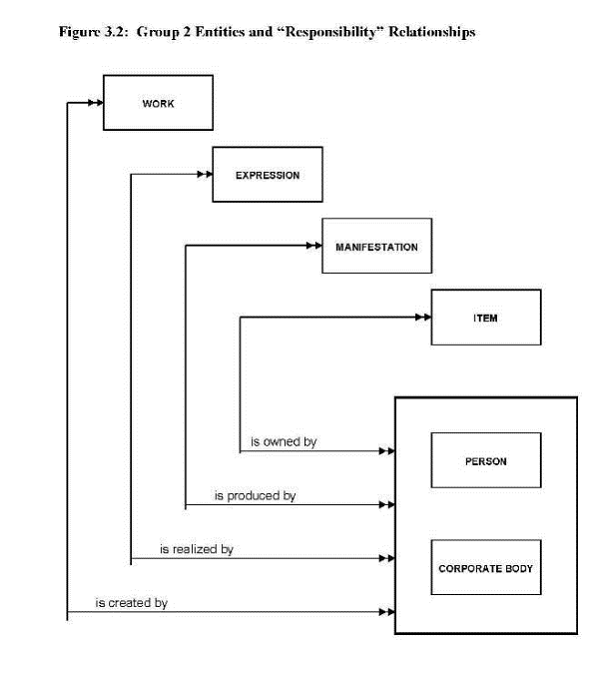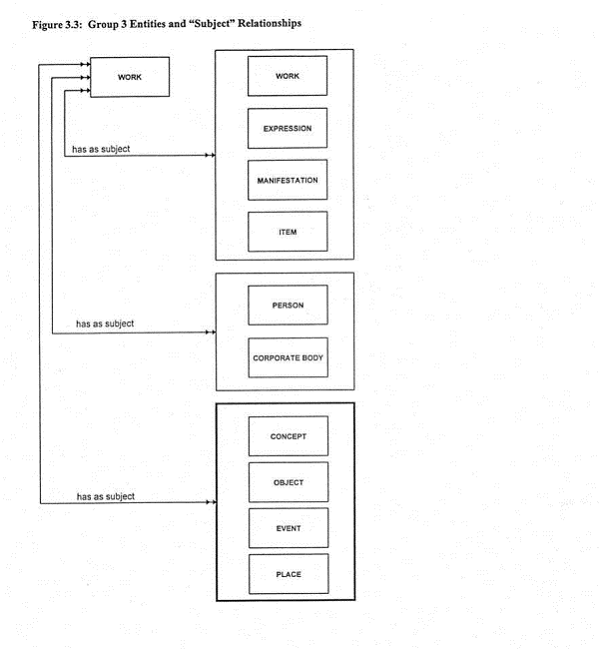How to use FRBR
What is FRBR?
"Functional Requirements for Bibliographical Records (FRBR) is a conceptual model of the bibliographical universe outlined in a 1998 report from the International Federation of Library Associations and Institutions (IFLA). The report uses entity-relationship analysis to "provide a clearly defined, structured framework for relating the data that are recorded in bibliographic records to the needs of the users of those records". (FRBR Report, p.7) The most influential parts of the FRBR report are the definitions of user tasks and bibliographical entities". (Quote from TechEssence, May 2006)
The FRBR model can be a useful and fundamental framework for metadata analysis and framework. Also, the model will help users to perform sucessful searches by presenting information about complex works in useful and intelligent ways.
FRBR bibliographic entities
FRBR defines three groups of entities.
I. The four entities of the first and and primary group, WORK, EXPRESSION, MANIFESTATION and ITEM represent different aspects of the resource.

WORK: a distinct intellectual or artistic cration. A Work is an abstract entity. The Work is recognised through individual realisations or Expressions of the Work. A Work is not a particular version of a film or a CD, but the intellectual creation that lies behind all the various Expressions of the Work. Because the notion of a Work is abstract, it is difficult to define precise boundaries for the entity. Translations from one language to another, musical transcriptions and arrangements, and dubbed or subtitled versions of a film are considered as different expressions of the same original work.
But when the modification of a Work involves a significant degree of independent intellectual or artistic effort, the result is viewed as a new Work. Thus paraphrases, rewritings, adaptations for children, parodies, musical variations on a theme and free transcriptions of a musical composition are considered to represent new works.
Examples
Martin A. Hansens book Løgneren is a work, and the film Løgneren by Knud Leif Thomsen, based on the novel by Martin A. Hansen, is a new work.
EXPRESSION: the intellectual or artistic realization of a work. An Expression is the specific form that a Work takes each time it is "realised". Expression encompasses the specific words and sentences that result from the realization of a work in the form of a text, or the particular sound resulting from the realization of a musical work. When an expression is accompanied by augmentations such as illustrations, CD cover, etc. that are nor integral to the intellectual or artistic realization of the work, such augmentation are considered to be separate expressions of their own separate work.
Examples
* work: Martin A. Hansens book Løgneren
- expression 1: the original Danish text
- expression 2: the radio broadcast read by Pouel Kern
- expression 3: the English translation by John J. Egglishaw
* work: the film Løgneren by Knud Leif Thomsen
- expression 1: the original Danish language version
- expression 2: the original with English subtitles added
MANIFESTATION: the physical embodiment of an expression of a work. A Manifestation may contain multiple Expressions, eg. a CD containing multiple songs, each of which is an Expression of an individual Work.
Examples
* work: Martin A. Hansens Løgneren
- expression 1: the original Danish text
- manifestation: the book published in 1950 by Gyldendal
- expression 2: the radio broadcast read by Pouel Kern
- manifestation: transmitted January 1950 by The Danish Radio
- expression 3: the English translation by John J. Egglishaw
- manifestation: the book published in 1954 by J.M. Dent
ITEM: a single exemplar of a manifestation. An Item is an individual copy of a Manifestation, whether a physical thing or a copy of a file.
Examples
* work: Martin A. Hansens Løgneren
- expression 1: the original Danish text
- manifestation: the book published in 1950 by Gyldendal
- item: the copy located at Statsbiblioteket: shelf no. 1-98-6622
- manifestation: the book published in 1950 by Gyldendal
- expression 2: the radio broadcast read by Pouel Kern
- manifestation: transmitted January 1950 by The Danish Radio
- item 1: the tape located at Statsbiblioteket: shelf no. DR15.1.1950
- item 2: the BWF-file located at Statsbiblioteket:
- manifestation: transmitted January 1950 by The Danish Radio
II. The two entities of the second group, PERSON and CORPORATE BODY, represent those responsible for the intellectual or artistic content, the physical production and dissemination, or the custodianship of the entities in the first group

PERSON: An individual. A person is treated as an entity if she/he is involved in the creation or realization of a work, or is the subject of a work.
Examples
* person 1: Suzanne Brøgger
* person 2: Martin A. Hansen
CORPORATE BODY: An organization or group of individuals and/or organizations acting as a unit. Encompasses organizations and groups of individuals that are identified by a particular name and groups that are constituted as meetings, conferences, etc.
Examples
* corporate body 1: Statsbiblioteket
* corporate body 2: Åstedet - arkiv og kulturværksted for den oversete historie
* corporate body 3: Arkiv for Ny Litteratur
III. The four entities of the third group, CONCEPT, OBJECT, EVENT, PLACE, represent an additional set of entities that serve as the subject of ''works''

CONCEPT: An abstract notion or idea. Encompasses abstractions that may be subject of a work: fields of knowledge, disciplines, schools of thought, theories, processes, techniques, etc.
Examples
concept 1: Eksistentialisme
concept 2: Arbejdererindringer i Århus
OBJECT: A material thing. Encompasses material things that may be subject of a work: animate and inanimate objects occuring in nature; fixed, moveable objects that are the product of human creation.
Examples
object 1: Amalienborg Slot
object 2: Fregatten Jylland
object 3: Himmelbjerget
EVENT: An action or occurrence. Encompasses actions and occurrences that may be the subject of a work: historical events, epochs, periods of time, etc.
Examples
event 1: Forfatteraften på Hald Hovedgaard
event 2: Slaget ved Dybbøl
PLACE: A location. Encompasses terrestrial and extra-terrestrial locations; historical and contemporary locations; geographic features and geo-political jurisdictions.
Examples
place 1: Dokken - Aarhus Flydedok
place 2: Hald Hovedgaard
How to use FRBR
![]() This section could use a more "whole" description of more than just the individual groups
This section could use a more "whole" description of more than just the individual groups
- Perhaps a more general usage specification
![]()
References
Amato, G. et al. (2000) Metadata modelling report. (The ECHO Project, D3.1.1)
Chen, Ya-ning and Shu-jiun Chen (2003) A metadata practice of the IFLA FRBR model - a case study for the National Palace Museum in Taipei (in: Journal of Documentation, vol. 60, no. 2, 2004)
IFLA Study Group on the Functional Requirements for Bibliographical Records (1998) Functional Requirements for Bibliographical Records: Final Report. Amended and corrected February 2009
International Association of Sound and Audiovisual Archives (2009) Guidelines on the Production and Preservation of Digital Audio Objects: Standards Recommended, Practices and Strategies. IASA-TC04. 2nd edition/ edited by Kevin Bradley.